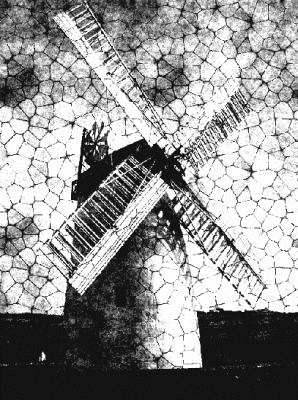
You can apply the Express Texture to generate a high-contrast version of an image in grayscale, which creates a visual effect similar to a custom halftone screen, like a mezzotint or line screen. When you use this effect, anti-aliasing is automatically applied to the image.
You need to choose a method for applying the effect. There are five different methods for applying Express Texture:
| • | Paper — adjusts light intensity by using the paper texture as a mapping model. If you want to experiment with the effect, keep the Papers panel open while you apply the effect. This way you can switch to different papers and modify the paper controls. |
| • | Image Luminance — uses the image’s brightness as the model for the adjustments |
| • | Original Luminance — uses the luminance of the clone source as the model for the adjustment |
| • | Alpha Channel or Layer Mask — sets the values in the alpha channel or layer mask as the model for the adjustments. You can use this method only if you have a saved channel or a layer mask in your image. |
An image with the Express Texture effect applied
| To apply Express Texture using image luminance |
|
| 1 . | To apply the effect to: |
| • | The canvas — Click the Canvas in the Layers panel. |
| • | A selection — Click a selection tool from the toolbox, and drag in the document window to select an area. |
| • | A layer — Click a layer in the Layers panel. |
| 2 . | Choose Effects |
| 3 . | Choose Image Luminance from the Using list box. |
| 4 . | Adjust any of the Express Texture controls. For information, see Express Texture controls. |
| To apply Express Texture using paper texture |
|
| 1 . | Choose Window |
| 2 . | Choose a paper swatch in the Paper Textures area. |
| 3 . | To apply the effect to: |
| • | The canvas — Click the Canvas in the Layers panel. |
| • | A selection — Click a selection tool from the toolbox, and drag in the document window to select an area. |
| • | A layer — Click a layer in the Layers panel. |
| 4 . | Choose Effects |
| 5 . | Choose Paper from the Using list box. |
| 6 . | Adjust any of the Express Texture controls. For information, see Express Texture controls. |
| To apply Express Texture using clone source or pattern luminance |
|
| 1 . | Open an image. |
| 2 . | Perform a task from the following table. |
|
In the Clone Source panel (Window
In the Embed Source Image dialog box, do one of the following:
Click OK.
|
||||||||||
| 3 . | Choose Effects |
| 4 . | Choose Original Luminance from the Using list box. |
| 5 . | Adjust any of the Express Texture controls. For information, see Express Texture controls. |
| To apply Express Texture using a layer mask or alpha channel |
|
| 1 . | Do one of the following: |
| • | To use a layer mask, choose Window |
| • | To use an alpha channel, choose Window |
| 2 . | Choose Effects |
| 3 . | Choose the layer mask or alpha channel from the Using list box. |
| 4 . | Adjust any of the Express Texture controls. For information, see Express Texture controls. |
| Express Texture controls |
|
| • | Gray Threshold — determines where the threshold is, between pure black and pure white |
| • | Grain — determines how deeply the texture penetrates the surface |
| • | Contrast — determines the number of levels of black and white. For example, low contrast generates pure gray, medium contrast produces levels of grayscale, and high contrast produces a black and white screen. |